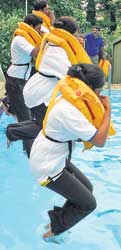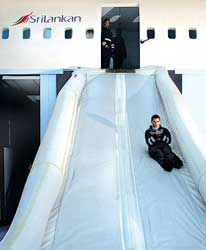
Learning the ropes at SriLankan“Unfasten the seat belts…come this way…exit over here…..jump and save!” The commands are fired in rapid succession and the crew reacts swiftly to evacuate the aircraft, sliding down the chute which serves as the emergency exit. This was the scene at the Katunayake International Airport last week, but no, it was not an emergency landing but a training session in progress. Here cabin crew of the airline and students of the International Aviation Academy (IAA) of SriLankan Airlines were being put through their paces on how to handle an emergency evacuation.
The IAA, launched in 2006 is the training department of SriLankan Airlines. It handles development training for both airline employees as well as for students. Located at the airport premises, the Academy has a range of courses for those interested in a career in different aspects of the aviation and travel industry. These include the International Diploma in Teaching and Training and courses in Fares and Ticketing , Dangerous Goods and Regulations, Aircraft Weight and Balance, Air Cargo Procedures and Skills, Flight Operations Officer/ Dispatcher Training and Airline Cabin Crew Training. The courses, IAA’s Manager HR Development, Sanjeeva Jayatileke says, are conducted by both internal as well as external facilitators. The internal facilitators are those who have been in the field for many years and have been specially trained for this role bringing with them their extensive experience on the job. External trainers are also brought in if more training is required in areas such as leadership development, communication, personality development, presentation skills and confidence building. When The Sunday Times visited the academy last week, the training course for cabin crew was in progress, with several practical exercises. Cabin crew members are entrusted with responsibility for the passengers’ safety which is the biggest component needed in addition to the service factor and hence are given a thorough training on safety measures by the Inflight Department. “There are two important requirements in the practical sessions for this course called the slide drill and the ditching drill where the participants are trained in the evacuation process in case of an emergency. We have the particular equipment to train them,” Mr. Jayatileke said.
Fire training was given with the use of a fire mock-up to enable them extinguish a small fire than can occur inside an air craft. Next came the ditching drill, which gives them the knowledge of life saving methods when an aircraft makes an emergency landing in water. Here they were taught how to rescue passengers, to inflate the raft etc. “In addition to our own cabin crew, many follow the course in order to get exposure to the field and enhance their knowledge. This could help them pursue a career in the airline field, here or even abroad,” Mr. Jayatileke said. The cabin crew programme which consists of one practical session is conducted over seven weeks. The courses are internationally recognized and are repeated two to three times a year. Course fees vary with the cabin crew training course, for example being Rs125,000 (+16% VAT). So does successful completion of these courses provide a direct pathway into the national airline as many young people dreaming of a career in aviation hope? No guarantee of employment is given but in the event that vacancies exist, preference is given to those who have followed the training course, say officials. For more details, check the IAA website; www.srilankan.aero/training/IAA.shtml |
|| Front
Page | News | Editorial | Columns | Sports | Plus | Financial
Times | International | Mirror | TV
Times | Funday
Times || |
| |
Reproduction of articles permitted when used without any alterations to contents and the source. |
© Copyright
2007 Wijeya
Newspapers Ltd.Colombo. Sri Lanka. All Rights Reserved. |

